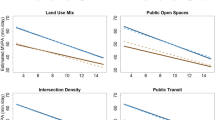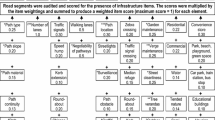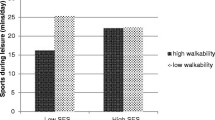Abstract
Features of the built environment that may influence physical activity (PA) levels are commonly captured using a so-called walkability index. Since such indices typically describe opportunities for walking in everyday life of adults, they might not be applicable to assess urban opportunities for PA in children. Particularly, the spatial availability of recreational facilities may have an impact on PA in children and should be additionally considered. We linked individual data of 400 2- to 9-year-old children recruited in the European IDEFICS study to geographic data of one German study region, based on individual network-dependent neighborhoods. Environmental features of the walkability concept and the availability of recreational facilities, i.e. playgrounds, green spaces, and parks, were measured. Relevant features were combined to a moveability index that should capture urban opportunities for PA in children. A gamma log-regression model was used to model linear and non-linear effects of individual variables on accelerometer-based moderate-to-vigorous physical activity (MVPA) stratified by pre-school children (<6 years) and school children (≥6 years). Single environmental features and the resulting indices were separately included into the model to investigate the effect of each variable on MVPA. In school children, commonly used features such as residential density \( \left(\widehat{\beta}=0.5\cdot {10}^{-4},p=0.02\right) \), intersection density \( \left(\widehat{\beta}=0.003,p=0.04\right) \), and public transit density \( \left(\widehat{\beta}=0.037,p=0.01\right) \) showed a positive effect on MVPA, while land use mix revealed a negative effect on MVPA \( \left(\widehat{\beta}=-0.173,p=0.13\right) \). In particular, playground density \( \left(\widehat{\beta}=0.048,p=0.01\right) \) and density of public open spaces, i.e., playgrounds and parks combined \( \left(\widehat{\beta}=0.040,p=0.01\right) \), showed positive effects on MVPA. However, availability of green spaces showed no effect on MVPA. Different moveability indices were constructed based on the walkability index accounting for the negative impact of land use mix. Moveability indices showed also strong effects on MVPA in school children for both components, expanded by playground density \( \left(\widehat{\beta}=0.014,p=0.008\right) \) or by public open space density \( \left(\widehat{\beta}=0.014,p=0.007\right) \), but no effects of urban measures and moveability indices were found in pre-school children. The final moveability indices capture relevant opportunities for PA in school children. Particularly, availability of public open spaces seems to be a strong predictor of MVPA. Future studies involving children should consider quantitative assessment of public recreational facilities in larger cities or urban sprawls in order to investigate the influence of the moveability on childhood PA in a broader sample.


Similar content being viewed by others
Notes
ESRI 2011. ArcGIS Desktop:Release 10. Redlands, CA: Environmental Systems Research Institute.
PROC GLIMMIX; SAS version 9.2, SAS Institute Inc, Cary, NC
References
Frank LD, Sallis JF, Saelens BE, et al. The development of a walkability index: application to the neighborhood quality of life study. British Journal of Sports Medicine. 2010; 44: 924–933.
Sallis JF, Bowles HR, Bauman A, et al. Neighborhood environments and physical activity among adults in 11 countries. American Journal of Preventive Medicine. 2009; 36: 484–490.
Frank LD, Schmid TL, Sallis JF, Chapman J, Saelens BE. Linking objectively measured physical activity with objectively measured urban form. American Journal of Preventive Medicine. 2005; 28: 117–125.
Freeman L, Neckerman K, Schwartz-Soicher O, et al. Neighborhood walkability and active travel (walking and cycling) in New York City. Journal of Urban Health. 2013; 90: 575–585.
Buehler R. Determinants of transport mode choice: a comparison of Germany and the USA. Journal of Transport Geography. 2011; 19: 644–657.
Norman GJ, Nutter SK, Ryan S, Sallis JF, Calfas KJ, Patrick K. Community design and access to recreational facilities as correlates of adolescent physical activity and body-mass index. Journal of Physical Activity & Health. 2006; 3: S118–S128.
Frank LD, Saelens BE, Chapman J, et al. Objective assessment of obesogenic environments in youth: geographic information system methods and spatial findings from the neighborhood impact on kids study. American Journal of Preventive Medicine. 2012; 42: e47–e55.
Haese Sara D, Van Dyck D, De Bourdeaudhuij I, Deforche B, Cardon G. The association between objective walkability, neighborhood socio-economic status, and physical activity in Belgian children. International Journal of Behavioral Nutrition and Physical Activity. 2014; 11: 104.
Andrews Gavin J, Hall E, Evans B, Colls R. Moving beyond walkability: on the potential of health geography. Social Science & Medicine. 2012; 75: 1925–1932.
Schipperijn Jasper, Ejstrud Bo, Troelsen Jens. Gis: A spatial turn in the health science? In: Neighbourhood structure and health promotion. US: Springer; 2013. p. 127–152. doi:10.1007/978-1-4614-6672-7_8.
Buck C, Pohlabeln H, Huybrechts I, et al. Development and application of a moveability index to quantify possibilities for physical activity in the built environment of children. Health & Place. 2011; 17: 1191–1201.
Wheeler BW, Cooper AR, Page AS, Jago R. Greenspace and children’s physical activity: a GPS/GIS analysis of the peach project. Preventive Medicine. 2010; 51: 148–152.
Cooper AR, Page AS, Wheeler BW, Hillsdon M, Griew P, Jago R. Research patterns of GPS measured time outdoors after school and objective physical activity in English children: the peach project. International Journal of Behavioral Nutrition and Physical Activity. 2010; 7: 31–39.
Roemmich JN, Epstein LH, Raja S, Yin L, Robinson J, Winiewicz D. Association of access to parks and recreational facilities with the physical activity of young children. Preventive Medicine. 2006; 43: 437–441.
Timperio A, Giles-Corti B, Crawford D, et al. Features of public open spaces and physical activity among children: findings from the clan study. Preventive Medicine. 2008; 47: 514–518.
Holt NL, Cunningham CT, Sehn ZL, Spence JC, Newton AS, Ball GDC. Neighborhood physical activity opportunities for inner-city children and youth. Health & Place. 2009; 15: 1022–1028.
Ahrens W, Bammann K, Siani A, et al. The IDEFICS cohort: design, characteristics and participation in the baseline survey. International Journal of Obesity. 2011; 35: S3–S15.
Ahrens W, Bammann K, De Henauw S, et al. Understanding and preventing childhood obesity and related disorders-IDEFICS: a European multilevel epidemiological approach. Nutrition, Metabolism, and Cardiovascular Diseases. 2006; 16: 302–308.
Cole TJ, Lobstein T. Extended international (IOTF) body mass index cut-offs for thinness, overweight and obesity. Pediatric Obesity. 2012; 7: 284–294.
Trost SG, Loprinzi PD, Moore R, Pfeiffer KA. Comparison of accelerometer cut points for predicting activity intensity in youth. Medicine & Science in Sports & Exercise. 2011; 43: 1360–1368.
Buck C, Dreger S, Pigeot I. Anonymisation of address coordinates for micro-level analyses of the built environment: a simulation study. BMJ Open 2014. submitted.
Cassa CA, Grannis SJ, Overhage JM, Mandl KD. A context-sensitive approach to anonymizing spatial surveillance data: impact on outbreak detection. Journal of the American Medical Informatics Association. 2006; 13: 160–165.
R Core Team. R: A Language and Environment for Statistical Computing. R Foundation for Statistical ComputingVienna, Austria 2013.
Maroko AR, Maantay JA, Sohler NL, Grady KL, Arno PS. The complexities of measuring access to parks and physical activity sites in New York city: a quantitative and qualitative approach. International Journal of Health Geographics. 2009; 8: 34–56.
Baddeley A, Turner R. Spatstat: an r package for analyzing spatial point patterns. Journal of Statistical Software. 2005; 12: 1–42.
Schabenberger O, Gotway CA. Statistical methods for spatial data analysis. New York, NY: Chapman & Hall/CRC; 2005.
Fyhri A, Hjorthol R. Children’s independent mobility to school, friends and leisure activities. Journal of Transport Geography. 2009; 17: 377–384.
Page AS, Cooper AR, Griew P, Jago R. Independent mobility, perceptions of the built environment and children’s participation in play, active travel and structured exercise and sport: the peach project. International Journal of Behavioral Nutrition and Physical Activity. 2010; 7: 17–26.
Carlos HA, Shi X, Sargent J, Tanski S, Berke EM. Density estimation and adaptive bandwidths: a primer for public health practitioners. International Journal of Health Geographics. 2010; 9: 39–46.
Acknowledgments
This work was funded by the German Research Foundation (DFG) under grant PI 345/7-1. Survey data was provided by the IDEFICS study (www.idefics.eu). We gratefully acknowledge the financial support of the European Community within the Sixth RTD Framework Programme Contract No. 016181 (FOOD). We also thank the public authorities of the city of Delmenhorst, particularly the municipal geospatial information system (Kommunales Raumbezogenes Informationssystem (KRIS)) of Delmenhorst.
Author information
Authors and Affiliations
Corresponding author
Rights and permissions
About this article
Cite this article
Buck, C., Tkaczick, T., Pitsiladis, Y. et al. Objective Measures of the Built Environment and Physical Activity in Children: From Walkability to Moveability. J Urban Health 92, 24–38 (2015). https://doi.org/10.1007/s11524-014-9915-2
Published:
Issue Date:
DOI: https://doi.org/10.1007/s11524-014-9915-2




